 This sturdy, pocket-sized field guide–the only one of its kind for north and central Florida–is designed for landscape professionals, arborists, naturalists, gardeners, and anyone seeking to know the trees around them. Full color photographs of leaves, bark, flowers and full trees, together with clear descriptions and other information make identifying trees easier than ever. The book also features a handy diagnostic key, an introduction to plant parts, a glossary and a ruler to guide you, whether you’re a trained botanist or a total beginner. This field guide to 140 common tree species is written by Andrew Koeser, Gitta Hasing, Melissa Friedman, and Robert Irving and published by UF/IFAS. Available only at the UF/IFAS Extension Bookstore.
This sturdy, pocket-sized field guide–the only one of its kind for north and central Florida–is designed for landscape professionals, arborists, naturalists, gardeners, and anyone seeking to know the trees around them. Full color photographs of leaves, bark, flowers and full trees, together with clear descriptions and other information make identifying trees easier than ever. The book also features a handy diagnostic key, an introduction to plant parts, a glossary and a ruler to guide you, whether you’re a trained botanist or a total beginner. This field guide to 140 common tree species is written by Andrew Koeser, Gitta Hasing, Melissa Friedman, and Robert Irving and published by UF/IFAS. Available only at the UF/IFAS Extension Bookstore.
Author: dihagan
Wellsina Mite Hemicheyletia wellsina (De Leon) (Arachnida: Acari: Cheyletidae)
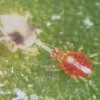 This predatory mite was recently discovered in an unsprayed greenhouse at the University of Florida, Gainesville, living on Phalaenopsis and Dendrobium orchids, and assumed to be feeding on orchid pests such as spider mites, tenuipalpid mites, and mealybugs that were present on the orchids. Because there was no published information on this species as a natural enemy of orchid pests, colonies were initiated here to study its biology, maintained on two-spotted spider mite prey. Hemicheyletia wellsina does not appear likely to be an effective natural enemy in agricultural crops as an introduced predator, but could be beneficial in natural biological control in natural ecosystems, where pest densities are lower. This 5-page fact sheet was written by Haleigh A. Ray and Marjorie A. Hoy, and published by the UF Department of Entomology and Nematology, December 2014. (Photo: Haleigh Ray, UF/IFAS)
This predatory mite was recently discovered in an unsprayed greenhouse at the University of Florida, Gainesville, living on Phalaenopsis and Dendrobium orchids, and assumed to be feeding on orchid pests such as spider mites, tenuipalpid mites, and mealybugs that were present on the orchids. Because there was no published information on this species as a natural enemy of orchid pests, colonies were initiated here to study its biology, maintained on two-spotted spider mite prey. Hemicheyletia wellsina does not appear likely to be an effective natural enemy in agricultural crops as an introduced predator, but could be beneficial in natural biological control in natural ecosystems, where pest densities are lower. This 5-page fact sheet was written by Haleigh A. Ray and Marjorie A. Hoy, and published by the UF Department of Entomology and Nematology, December 2014. (Photo: Haleigh Ray, UF/IFAS)
http://edis.ifas.ufl.edu/in1066
Io Moth Automeris io (Fabricius) (Insecta: Lepidoptera: Saturniidae)
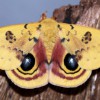 The beautiful Io moth is one of our most recognizable moths, because of its prominent hind wing eyespots. The attractive Io moth caterpillar is also well-known because of its painful sting. But like many of the other saturniid moths, is less common now in parts of its range. With the exception of Cape Cod and some of the Massachusetts islands, it is now rare in New England where it was once common, and its populations have declined in most of the Gulf States since the 1970s. This 12-page fact sheet was written by Donald W. Hall, and published by the UF Department of Entomology and Nematology, December 2014. (Photo: Donald W. Hall, UF/IFAS)
The beautiful Io moth is one of our most recognizable moths, because of its prominent hind wing eyespots. The attractive Io moth caterpillar is also well-known because of its painful sting. But like many of the other saturniid moths, is less common now in parts of its range. With the exception of Cape Cod and some of the Massachusetts islands, it is now rare in New England where it was once common, and its populations have declined in most of the Gulf States since the 1970s. This 12-page fact sheet was written by Donald W. Hall, and published by the UF Department of Entomology and Nematology, December 2014. (Photo: Donald W. Hall, UF/IFAS)
http://edis.ifas.ufl.edu/in1065
The Florida Panther: Past, Present, and Future
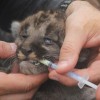 Florida panther was presumed extinct by the early 1950s, but were rediscovered in 1973 by a survey team organized by the National Geographic Society. They were one of the first species to be added to the US endangered species list and are now the only population of North American puma that occurs east of Mississippi River. This 3-page fact sheet describes Florida panther research and management actions, the effects they have had on the population, and continuing challenges. Written by Madelon van de Kerk, David P. Onorato, and Madan K. Oli, and published by the UF Department of Wildlife Ecology and Conservation, February 2015.
Florida panther was presumed extinct by the early 1950s, but were rediscovered in 1973 by a survey team organized by the National Geographic Society. They were one of the first species to be added to the US endangered species list and are now the only population of North American puma that occurs east of Mississippi River. This 3-page fact sheet describes Florida panther research and management actions, the effects they have had on the population, and continuing challenges. Written by Madelon van de Kerk, David P. Onorato, and Madan K. Oli, and published by the UF Department of Wildlife Ecology and Conservation, February 2015.
http://edis.ifas.ufl.edu/uw402
Yellowmargined Leaf Beetle: A Pest of Cole Crops
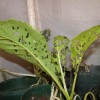 The yellowmargined leaf beetle is a pest of cole or cruciferous crops that is native to South America. Since first reported in Mobile, Alabama, in 1947, the beetle has spread throughout the Gulf Coast from Texas to Florida and up into Georgia and North Carolina. It has also been reported from Illinois and California. Not considered a major pest in conventionally grown cruciferous crops because it is susceptible to a wide range of insecticides, it poses a significant threat to the growing organic industry in the southeastern United States. It is a particular problem on Asian greens such as mizuna, mibuna, and napa cabbage, as well as on other high-value cruciferous crops like turnip, mustard, and watercress. This 4-page fact sheet was written by Elena M. Rhodes and and Oscar E. Liburd, and published by the UF Department of Entomology and Nematology, September 2014.
The yellowmargined leaf beetle is a pest of cole or cruciferous crops that is native to South America. Since first reported in Mobile, Alabama, in 1947, the beetle has spread throughout the Gulf Coast from Texas to Florida and up into Georgia and North Carolina. It has also been reported from Illinois and California. Not considered a major pest in conventionally grown cruciferous crops because it is susceptible to a wide range of insecticides, it poses a significant threat to the growing organic industry in the southeastern United States. It is a particular problem on Asian greens such as mizuna, mibuna, and napa cabbage, as well as on other high-value cruciferous crops like turnip, mustard, and watercress. This 4-page fact sheet was written by Elena M. Rhodes and and Oscar E. Liburd, and published by the UF Department of Entomology and Nematology, September 2014.
http://edis.ifas.ufl.edu/in1049
Hairy Indigo Control in Peanut
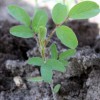 Hairy indigo is an annual legume that was introduced to Florida as a forage crop. It has since escaped cultivation and can be a troublesome weed in some crop settings, particularly in peanut production, since we are attempting to control a legume weed in a legume crop. This 2-page fact sheet was written by Jason Ferrell, Blaire Colvin, and Ramon Leon, and published by the UF Department of Agronomy, March 2015. (Photo by Blaire Colvin, UF/IFAS)
Hairy indigo is an annual legume that was introduced to Florida as a forage crop. It has since escaped cultivation and can be a troublesome weed in some crop settings, particularly in peanut production, since we are attempting to control a legume weed in a legume crop. This 2-page fact sheet was written by Jason Ferrell, Blaire Colvin, and Ramon Leon, and published by the UF Department of Agronomy, March 2015. (Photo by Blaire Colvin, UF/IFAS)
http://edis.ifas.ufl.edu/ag391
Habitat Requirements of the Florida Panther
 The Florida panther (Puma concolor coryi) was listed as endangered under the Endangered Species Act in 1967. Habitat loss and fragmentation are primary threats, driven by urban development and the conversion of rangelands to row crops, citrus production, and mining. This 3-page fact sheet focuses on which habitats are most important for conservation of the Florida panther. Written by Elizabeth F. Pienaar and Elena C. Rubino, and published by the UF Department of Wildlife Ecology and Conservation, October 2014. (Photo courtesy of the Florida Fish and Wildlife Conservation Commission.)
The Florida panther (Puma concolor coryi) was listed as endangered under the Endangered Species Act in 1967. Habitat loss and fragmentation are primary threats, driven by urban development and the conversion of rangelands to row crops, citrus production, and mining. This 3-page fact sheet focuses on which habitats are most important for conservation of the Florida panther. Written by Elizabeth F. Pienaar and Elena C. Rubino, and published by the UF Department of Wildlife Ecology and Conservation, October 2014. (Photo courtesy of the Florida Fish and Wildlife Conservation Commission.)
http://edis.ifas.ufl.edu/uw390
Selecting Cultivars of Lettuce For Production Using Hydroponics and Protected Culture in Florida
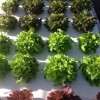 With correct variety selection and protected culture strategies, lettuce is a crop that can present even the novice grower with a fast-growing commodity for market sale. Includes brief descriptions of hydroponic lettuce production systems, cultivars, and a table summarizing the lettuce types successfully grown in Florida using protected agriculture and hydroponic techniques. This 6-page fact sheet was written by Natalie B. Parkell, Robert C. Hochmuth, and Wanda L. Laughlin, and published by the UF Department of Horticultural Sciences, March 2015. (Photo: UF/IFAS)
With correct variety selection and protected culture strategies, lettuce is a crop that can present even the novice grower with a fast-growing commodity for market sale. Includes brief descriptions of hydroponic lettuce production systems, cultivars, and a table summarizing the lettuce types successfully grown in Florida using protected agriculture and hydroponic techniques. This 6-page fact sheet was written by Natalie B. Parkell, Robert C. Hochmuth, and Wanda L. Laughlin, and published by the UF Department of Horticultural Sciences, March 2015. (Photo: UF/IFAS)
http://edis.ifas.ufl.edu/hs1258
Cooperative Learning for 4-H
 A simple way to facilitate discovery through cooperative learning, in which learners work together to meet a shared goal with a leader guiding them to encourage group interactions. This 5-page fact sheet provides teaching techniques and applies cooperative learning to natural resources and environmental literacy in the context of 4-H. Written by Jessica McIntosh and Martha Monroe, and published by the UF Department of School of Forest Resources and Conservation, September 2014.
A simple way to facilitate discovery through cooperative learning, in which learners work together to meet a shared goal with a leader guiding them to encourage group interactions. This 5-page fact sheet provides teaching techniques and applies cooperative learning to natural resources and environmental literacy in the context of 4-H. Written by Jessica McIntosh and Martha Monroe, and published by the UF Department of School of Forest Resources and Conservation, September 2014.
http://edis.ifas.ufl.edu/fr390
The Extension Services-237 Report: Everything You Need to Know
 The Extension Services-237 (ES-237) is a report of the Cooperative Extension Service that consists of enrollment statistics for youth ages 5–18 participating in Extension youth programs and the volunteers providing service to these programs. Since partial funding for Extension youth programs is received through the USDA, each county and state must report each year on the race, gender, grade, and residence of each participant in these programs. In Florida, the report is completed by each UF/IFAS county Extension office each year using 4HOnline, then submitted to Florida 4-H state headquarters where they are compiled into a single state report and submitted to the National Institute of Food and Agriculture (NIFA) at the United States Department of Agriculture (USDA). This 6-page fact sheet was written by Ben Knowles and Tracy A. Tesdall, and published by the UF Department of 4-H Youth Development, October 2014.
The Extension Services-237 (ES-237) is a report of the Cooperative Extension Service that consists of enrollment statistics for youth ages 5–18 participating in Extension youth programs and the volunteers providing service to these programs. Since partial funding for Extension youth programs is received through the USDA, each county and state must report each year on the race, gender, grade, and residence of each participant in these programs. In Florida, the report is completed by each UF/IFAS county Extension office each year using 4HOnline, then submitted to Florida 4-H state headquarters where they are compiled into a single state report and submitted to the National Institute of Food and Agriculture (NIFA) at the United States Department of Agriculture (USDA). This 6-page fact sheet was written by Ben Knowles and Tracy A. Tesdall, and published by the UF Department of 4-H Youth Development, October 2014.
http://edis.ifas.ufl.edu/4h345
Nutrient Management of Vegetable and Agronomic Row Crops Handbook
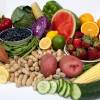 Through the implementation of a series of targeted cultural practices discussed in this production guide, growers should be able to reconcile economic profitability and responsible use of water and fertilizer. Topics include: proper sampling practices and test interpretations; irrigation management methods and automation; use of alternate fertilizer materials to retain nutrients in the soil but allow adequate supply for crop uptake. Use of these BMPs ensures that adequate fertilizer rates may be achieved by combinations of UF/IFAS recommended base rates and supplemental fertilizer applications. This 199-page handbook was edited by Kelly T. Morgan, and published by the UF Department of Soil and Water Science, February 2015.
Through the implementation of a series of targeted cultural practices discussed in this production guide, growers should be able to reconcile economic profitability and responsible use of water and fertilizer. Topics include: proper sampling practices and test interpretations; irrigation management methods and automation; use of alternate fertilizer materials to retain nutrients in the soil but allow adequate supply for crop uptake. Use of these BMPs ensures that adequate fertilizer rates may be achieved by combinations of UF/IFAS recommended base rates and supplemental fertilizer applications. This 199-page handbook was edited by Kelly T. Morgan, and published by the UF Department of Soil and Water Science, February 2015.
http://edis.ifas.ufl.edu/ss639
Alimentacion Saludable: Nutricion y diabetes
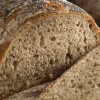 Una dieta saludable, junto con ejercicio y medicinas, pueden ayudar a controlar la diabetes y reducir el riesgo de complicaciones. Un estilo de vida saludable también ayuda a personas con alto riesgo de diabetes a reducir las probabilidades de padecer de esta enfermedad. Para una dieta saludable, siga estos consejos. This 3-page fact sheet was written by Linda B. Bobroff, Jennifer Hillan, y Emily Minton, and published by the UF Department of Family Youth and Community Sciences, February 2015.
Una dieta saludable, junto con ejercicio y medicinas, pueden ayudar a controlar la diabetes y reducir el riesgo de complicaciones. Un estilo de vida saludable también ayuda a personas con alto riesgo de diabetes a reducir las probabilidades de padecer de esta enfermedad. Para una dieta saludable, siga estos consejos. This 3-page fact sheet was written by Linda B. Bobroff, Jennifer Hillan, y Emily Minton, and published by the UF Department of Family Youth and Community Sciences, February 2015.
http://edis.ifas.ufl.edu/fy665
De compras para la salud: Comidas para una persona
 En el mundo ajetreado de hoy, muchos estadounidenses se encuentran cocinando para ellos mismos. Los adultos mayores y estudiantes universitarios por igual, se enfrentan al desafío de preparar la comida como una prioridad, cuando nadie más se encarga de ellos para crear una comida balanceada. Ya sea que usted coloque una comida en el microondas después de un día muy ocupado, o pase tiempo cocinando una comida especial para usted, comprar y preparar comidas saludables para uno mismo a bajo costo puede ser agradable, simplemente con un poco de planificación. This 5-page fact sheet is the Spanish language version of FSHN13-02/FS224: Shopping for Health: A Menu for One. It was written by Morgan Denhard and Wendy Dahl, and published by the UF Department of Food Science and Human Nutrition, February 2015. (Photo: Thinkstock.com)
En el mundo ajetreado de hoy, muchos estadounidenses se encuentran cocinando para ellos mismos. Los adultos mayores y estudiantes universitarios por igual, se enfrentan al desafío de preparar la comida como una prioridad, cuando nadie más se encarga de ellos para crear una comida balanceada. Ya sea que usted coloque una comida en el microondas después de un día muy ocupado, o pase tiempo cocinando una comida especial para usted, comprar y preparar comidas saludables para uno mismo a bajo costo puede ser agradable, simplemente con un poco de planificación. This 5-page fact sheet is the Spanish language version of FSHN13-02/FS224: Shopping for Health: A Menu for One. It was written by Morgan Denhard and Wendy Dahl, and published by the UF Department of Food Science and Human Nutrition, February 2015. (Photo: Thinkstock.com)
http://edis.ifas.ufl.edu/fs266
Bismarckia nobilis: Bismarck Palm
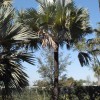 The Bismarck palm is a native of Madagascar that grows to a height of 30 to 60 feet with a spread of 12 to 16 feet. The massive 4-foot-wide costapalmate leaves are typically silver-green in color, but a light olive-green-leaved variety also exists. The persistent leaf bases are split, creating an attractive pattern on the 15–18-inch-diameter trunks. The dark brown male and female inflorescences are produced on separate trees, with females developing olive-brown fruit about 1.5 inches in diameter. The bold texture and color and eventual great height of this species make a strong statement in any setting, but can be overpowering in small residential landscapes. This 3-page fact sheet was written by Timothy Broschat, and published by the UF Department of Environmental Horticulture, February 2015. (Photo credit: T. K. Broschat)
The Bismarck palm is a native of Madagascar that grows to a height of 30 to 60 feet with a spread of 12 to 16 feet. The massive 4-foot-wide costapalmate leaves are typically silver-green in color, but a light olive-green-leaved variety also exists. The persistent leaf bases are split, creating an attractive pattern on the 15–18-inch-diameter trunks. The dark brown male and female inflorescences are produced on separate trees, with females developing olive-brown fruit about 1.5 inches in diameter. The bold texture and color and eventual great height of this species make a strong statement in any setting, but can be overpowering in small residential landscapes. This 3-page fact sheet was written by Timothy Broschat, and published by the UF Department of Environmental Horticulture, February 2015. (Photo credit: T. K. Broschat)
http://edis.ifas.ufl.edu/st101
Impacto de las variedades de tomate y su estado de madurez en la susceptibilidad a Salmonella
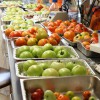 De 1998 a 2007 la fruta fresca, verdura, especias y nueces fueron comúnmente asociados con brotes de gastroenteritis (Batz, Hoffman, y Morris 2011). Salmonella se ha convertido en uno de los patógenos humanos más problemáticos asociado a productos frescos, nueces y a los alimentos que contienen esos ingredientes (Batz, Hoffman, y Morris 2011; deWaal, Tian, y Plunkett 2009). Esta hoja informativa fue producida para proveer información actualizada sobre las prácticas de producción de tomate y sus asociaciones con Salmonella. Esta información es útil para los Agentes de Extensión Agraria en sus programas de educación sobre cultivos hortícolas. This 3-page fact sheet is the Spanish language version of Impact of Tomato Varieties and Maturity State on Susceptibility of Tomatoes to Salmonella (SS627). It was written by Massimiliano Marvasi, Max Teplitski, and George Hochmuth, and published by the UF Department of Soil and Water Science, February 2015. (Photo: Max Teplitski)
De 1998 a 2007 la fruta fresca, verdura, especias y nueces fueron comúnmente asociados con brotes de gastroenteritis (Batz, Hoffman, y Morris 2011). Salmonella se ha convertido en uno de los patógenos humanos más problemáticos asociado a productos frescos, nueces y a los alimentos que contienen esos ingredientes (Batz, Hoffman, y Morris 2011; deWaal, Tian, y Plunkett 2009). Esta hoja informativa fue producida para proveer información actualizada sobre las prácticas de producción de tomate y sus asociaciones con Salmonella. Esta información es útil para los Agentes de Extensión Agraria en sus programas de educación sobre cultivos hortícolas. This 3-page fact sheet is the Spanish language version of Impact of Tomato Varieties and Maturity State on Susceptibility of Tomatoes to Salmonella (SS627). It was written by Massimiliano Marvasi, Max Teplitski, and George Hochmuth, and published by the UF Department of Soil and Water Science, February 2015. (Photo: Max Teplitski)
http://edis.ifas.ufl.edu/ss629
Contribucion de las practicas de produccion de cultivos y las condiciones climaticas a la seguridad microbiologica de los tomates y pimientos
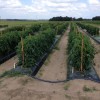 Durante la última década, las frutas, verduras y frutos secos se encuentran entre los alimentos relacionados con brotes de gastroenteritis causadas por cepas enterovirulentas de E. coli y Salmonella no tifoidea que resultan en miles de hospitalizaciones y pérdidas de varios millones de dólares en la industria de alimentos (Mandrell 2009; Batz, Hoffman, y Morris 2011). Desde 2006, dieciséis brotes de salmonelosis se han relacionado con el consumo de frutas y verduras, incluyendo tomates, melones, coles, pepinos, mangos, piñones, pistachos, mantequilla de maní, papayas, pimientos y además alimentos congelados y procesados que contienen productos vegetales. Esta hoja informativa fue producida para proveer información actualizada sobre las prácticas de producción de tomate y sus asociaciones con Salmonella. Esta información es útil para Agentes de Extensión Agraria en sus programas de educación sobre cultivos hortícolas. This 4-page fact sheet is the Spanish language version of The Role of Crop Production Practices and Weather Conditions in Microbiological Safety of Tomatoes and Peppers (SS628). It was written by Massimiliano Marvasi, Max Teplitski, and George Hochmuth, and published by the UF Department of Soil and Water Science, February 2015.
Durante la última década, las frutas, verduras y frutos secos se encuentran entre los alimentos relacionados con brotes de gastroenteritis causadas por cepas enterovirulentas de E. coli y Salmonella no tifoidea que resultan en miles de hospitalizaciones y pérdidas de varios millones de dólares en la industria de alimentos (Mandrell 2009; Batz, Hoffman, y Morris 2011). Desde 2006, dieciséis brotes de salmonelosis se han relacionado con el consumo de frutas y verduras, incluyendo tomates, melones, coles, pepinos, mangos, piñones, pistachos, mantequilla de maní, papayas, pimientos y además alimentos congelados y procesados que contienen productos vegetales. Esta hoja informativa fue producida para proveer información actualizada sobre las prácticas de producción de tomate y sus asociaciones con Salmonella. Esta información es útil para Agentes de Extensión Agraria en sus programas de educación sobre cultivos hortícolas. This 4-page fact sheet is the Spanish language version of The Role of Crop Production Practices and Weather Conditions in Microbiological Safety of Tomatoes and Peppers (SS628). It was written by Massimiliano Marvasi, Max Teplitski, and George Hochmuth, and published by the UF Department of Soil and Water Science, February 2015.
http://edis.ifas.ufl.edu/ss630
Robbing Behavior in Honey Bees
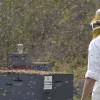 Western honey bee workers can invade and steal honey/nectar from other colonies or sugar/corn syrup from feeders used to deliver syrup to other colonies. This is called “robbing” behavior. Robbing behavior typically involves the collection of nectar and honey, but not pollen or brood. Some beekeepers report that robbing bees may steal wax or propolis from other hives, but there is not much data available on this occurrence. Robbing behavior can escalate quickly from just a few bees robbing other colonies to a massive frenzy of bees robbing many colonies in an apiary. This 3-page fact sheet was written by Ryan Willingham, Jeanette Klopchin, and James Ellis, and published by the UF Department of Entomology and Nematology, February 2015. (Photo Credit: UF/HBREL)
Western honey bee workers can invade and steal honey/nectar from other colonies or sugar/corn syrup from feeders used to deliver syrup to other colonies. This is called “robbing” behavior. Robbing behavior typically involves the collection of nectar and honey, but not pollen or brood. Some beekeepers report that robbing bees may steal wax or propolis from other hives, but there is not much data available on this occurrence. Robbing behavior can escalate quickly from just a few bees robbing other colonies to a massive frenzy of bees robbing many colonies in an apiary. This 3-page fact sheet was written by Ryan Willingham, Jeanette Klopchin, and James Ellis, and published by the UF Department of Entomology and Nematology, February 2015. (Photo Credit: UF/HBREL)
http://edis.ifas.ufl.edu/in1064
Datos sobre el potasio
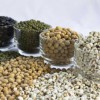 El potasio es un mineral que se encuentra dentro de las células del cuerpo. Es uno de algunos minerales conocidos como electrolitos. Estos minerales (potasio, sodio y cloro) se encuentran en los fluidos dentro y fuera de las células del cuerpo. This 2-page fact sheet is the Spanish language version of Facts about Potassium written by R. Elaine Turner and Linda B. Bobroff, and published by the UF Department of Family Youth and Community Sciences, February 2015.
El potasio es un mineral que se encuentra dentro de las células del cuerpo. Es uno de algunos minerales conocidos como electrolitos. Estos minerales (potasio, sodio y cloro) se encuentran en los fluidos dentro y fuera de las células del cuerpo. This 2-page fact sheet is the Spanish language version of Facts about Potassium written by R. Elaine Turner and Linda B. Bobroff, and published by the UF Department of Family Youth and Community Sciences, February 2015.
http://edis.ifas.ufl.edu/fy1214
Economic Impacts of Highway Beautification in Florida
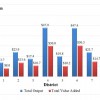 The Florida Department of Transportation is allocated money every year for highway landscaping projects. They make driving more pleasant and are better for the environment, but do they attract private investment and contribute to the economy? This study, commissioned by the FDOT, finds that the average annual economic impacts of highway beautification expenditures in Florida during 2008–2013 amounted to $46 million in output impacts and $28 million in value-added impacts. This 7-page fact sheet was written by Hayk Khachatryan, Alan W. Hodges, Mohammad Rahmani, and Thomas J. Stevens, and published by the UF Department of Food and Resource Economics, December 2014.
The Florida Department of Transportation is allocated money every year for highway landscaping projects. They make driving more pleasant and are better for the environment, but do they attract private investment and contribute to the economy? This study, commissioned by the FDOT, finds that the average annual economic impacts of highway beautification expenditures in Florida during 2008–2013 amounted to $46 million in output impacts and $28 million in value-added impacts. This 7-page fact sheet was written by Hayk Khachatryan, Alan W. Hodges, Mohammad Rahmani, and Thomas J. Stevens, and published by the UF Department of Food and Resource Economics, December 2014.
http://edis.ifas.ufl.edu/fe963
De compras para la salud: Las hierbas y las especias
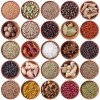 Las hierbas y las especias han sido usadas durante cientos de años en la cocina y en la medicina. Estas añaden una amplia gama de sabores a los alimentos y también pueden proporcionar beneficios para salud. Para algunas personas, el uso de hierbas y de especias en la cocina puede ser un reto—¡pero no tiene qué ser así! La siguiente información le permitirá estar en un buen camino para disfrutar de una sazón sabrosa y saludable.This 4-page fact sheet is the Spanish language version of Shopping for Health: Herbs and Spices, written by Jenna A. Norris and Wendy J. Dahl, and published by the UF Department of Food Science and Human Nutrition, January 2015.
Las hierbas y las especias han sido usadas durante cientos de años en la cocina y en la medicina. Estas añaden una amplia gama de sabores a los alimentos y también pueden proporcionar beneficios para salud. Para algunas personas, el uso de hierbas y de especias en la cocina puede ser un reto—¡pero no tiene qué ser así! La siguiente información le permitirá estar en un buen camino para disfrutar de una sazón sabrosa y saludable.This 4-page fact sheet is the Spanish language version of Shopping for Health: Herbs and Spices, written by Jenna A. Norris and Wendy J. Dahl, and published by the UF Department of Food Science and Human Nutrition, January 2015.
http://edis.ifas.ufl.edu/fs264